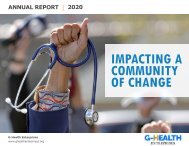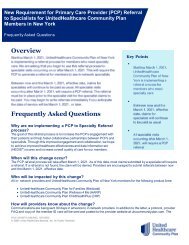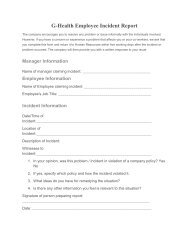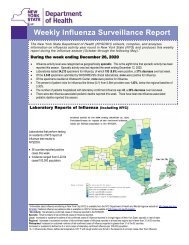Future of Health Care 2020
- No tags were found...
Create successful ePaper yourself
Turn your PDF publications into a flip-book with our unique Google optimized e-Paper software.
THE FUTURE OF HEALTH CARE // BEHAVIORAL HEALTH<br />
Behavioral health struggles a concern for young adults<br />
CONTINUED FROM PAGE 18<br />
to managing their emotions, and that<br />
can be difficult for someone who is not<br />
used to doing that,” Tevens said.<br />
The 24/7 accessibility to work is<br />
putting a lot more stress and pressure<br />
on this group, said Lindsay Herndon,<br />
director <strong>of</strong> outpatient services at<br />
BryLin Behavioral <strong>Health</strong> System.<br />
“They are so focused on their goals,<br />
and what it takes to achieve them,<br />
that’s just one more thing placed<br />
on them,” Herndon said. “They are<br />
caught up in life and afraid to look<br />
like a failure.”<br />
Shifting family dynamics and the<br />
recent mounting bad news only adds<br />
to the group’s anxiety.<br />
Social isolation from the coronavirus<br />
hasn’t made their situation any<br />
easier. And they won’t seek help, she<br />
said.<br />
Contributing to their mental<br />
problems is the Covid-19 impact on the<br />
workforce. It is a shock particularly to<br />
this age group with no work perspective,<br />
said Kenneth Houseknecht, executive<br />
director <strong>of</strong> Mental <strong>Health</strong> Advocates <strong>of</strong><br />
Western New York.<br />
“Any employee 30 years or younger<br />
has never worked in an economic<br />
slowdown,” he said. “We’ve gone from<br />
the lowest unemployment in February<br />
to the highest since the Great Depression<br />
in two months.”<br />
Even before the challenges <strong>of</strong><br />
Covid-19, this young-adult age group<br />
had the highest prevalence <strong>of</strong> mental,<br />
behavioral or emotional disorder<br />
among adults at about 26 percent,<br />
according to a 2017 study by the<br />
National Institute <strong>of</strong> Mental <strong>Health</strong>.<br />
At the same time, the percentage<br />
<strong>of</strong> this group who received mentalhealth<br />
services, at 38 percent, was<br />
lower than other adult groups, the<br />
study found.<br />
And yet, this group, more than any<br />
other that came before, is attracted<br />
to employers who are sensitive to the<br />
mental health <strong>of</strong> their workers and<br />
recognize the necessity <strong>of</strong> work-life<br />
balance, Houseknecht said.<br />
To attract and keep younger<br />
employees, he said, the company culture,<br />
philosophy and leaders need to<br />
address the whole person, including<br />
JOED VIERA<br />
The Covid-19 crisis has shocked young adults, says Kenneth Houseknecht <strong>of</strong> the Mental <strong>Health</strong> Advocates <strong>of</strong> WNY.<br />
mental health.<br />
How that can take shape is to start<br />
at a basic level, Roman said.<br />
“We want the people we work for<br />
to take an interest in us as individuals<br />
and not as workers,” he said. “We<br />
want an openness and transparency<br />
and to make sure that our voices are<br />
being heard.”<br />
WORD FROM THE SPONSOR: SPECTRUM HEALTH & HUMAN SERVICES<br />
Telehealth in Behavioral <strong>Health</strong> — Now and the <strong>Future</strong><br />
COVID-19 has generated an<br />
immediate need for behavioral<br />
health agencies to pivot to virtual<br />
services options (telephonic or televideo)<br />
to sustain critical mental health<br />
and addiction services for those in<br />
need. This includes at the provider<br />
level virtual team meetings and<br />
virtual supervision for clinicians who<br />
are delivering services.<br />
The loosening <strong>of</strong> regulations by<br />
the State and Federal governments for<br />
Medicaid and Medicare consumers,<br />
as well as commercial insurance<br />
companies waving copays for<br />
telehealth services makes virtual<br />
service delivery a viable alternative.<br />
While most providers were<br />
doing some telehealth, the need to<br />
go completely virtual has placed<br />
tremendous pressure on:<br />
• Payers and regulators<br />
• Getting consumers to accept the<br />
new paradigm<br />
• Need to train staff<br />
Clinical pr<strong>of</strong>essionals need formal<br />
training to assure privacy, security<br />
Bruce Nisbet is<br />
President/CEO<br />
<strong>of</strong> Spectrum<br />
<strong>Health</strong> & Human<br />
Services<br />
and effectiveness<br />
<strong>of</strong> treatment<br />
delivered with<br />
this new modality<br />
(e.g. transfer <strong>of</strong><br />
skills from face to<br />
face to virtual).<br />
The consumer<br />
adoption and<br />
readiness is<br />
variable. .Some<br />
consumers seem<br />
to like telephonic<br />
counseling<br />
and clinicians<br />
report that in<br />
many cases the consumers seem<br />
more comfortable discussing their<br />
challenges when it is not face to face<br />
and telephonic or virtual. Other<br />
consumers are much less comfortable<br />
with one <strong>of</strong> the virtual approaches.<br />
Other challenges that effect some<br />
consumers is the availability <strong>of</strong><br />
sufficient telephone minutes for ongoing<br />
telephonic counseling, capacity<br />
<strong>of</strong> their phone to connect to video<br />
telehealth or access to a computer<br />
with internet access and privacy..<br />
Advocacy by the State has helped<br />
to have some phone and internet<br />
providers allow unlimited minutes<br />
for Medicaid and Medicare recipients<br />
as well as more access to the internet.<br />
This is critical so large numbers <strong>of</strong><br />
consumers in poverty can access<br />
treatment services.<br />
Payers are <strong>of</strong>fering during this<br />
crisis the following:<br />
• Waving cost sharing for innetwork,<br />
non-COVID-19 behavioral<br />
health visits<br />
• Waivers are in place until May or<br />
June <strong>2020</strong><br />
• Video and telephonic visits<br />
allowed<br />
• New billing codes to support<br />
these changes<br />
With over 25% <strong>of</strong> the country’s<br />
workforce unemployed, research<br />
(Kaiser Family Foundation April<br />
<strong>Health</strong> Tracking Poll) shows that<br />
job loss is associated with increased<br />
depression, anxiety, distress, and low<br />
self-esteem and may lead to higher<br />
rates <strong>of</strong> substance use disorder and<br />
suicide. The polling data shows that<br />
more than half <strong>of</strong> the people who<br />
lost income or employment reported<br />
negative mental health impacts from<br />
worry or stress over coronavirus; and<br />
lower income people report higher<br />
rates <strong>of</strong> major negative mental health<br />
impacts compared to higher income<br />
people.<br />
In addition to the job loss burden<br />
effecting behavioral health needs,<br />
the effect <strong>of</strong> social isolation due to<br />
mandatory stay at home orders is<br />
also contributing to mental health<br />
challenges. The Kaiser Poll referenced<br />
above found that 47% <strong>of</strong> those<br />
sheltering in place reported negative<br />
mental health effects resulting from<br />
worry or stress related to coronavirus.<br />
With these new stressors on our<br />
community population, telehealth is<br />
the key for access to behavioral health<br />
treatment. The future <strong>of</strong> behavioral<br />
healthcare will have telehealth<br />
become a major vehicle to provide<br />
services to overcome current and<br />
new challenges and increasingly the<br />
preference <strong>of</strong> consumers.<br />
22 THE FUTURE OF HEALTH CARE BUFFALO BUSINESS FIRST


















